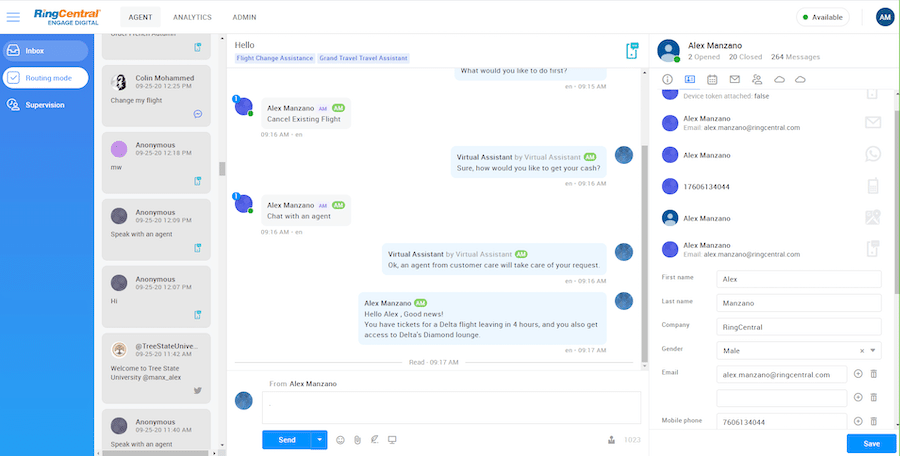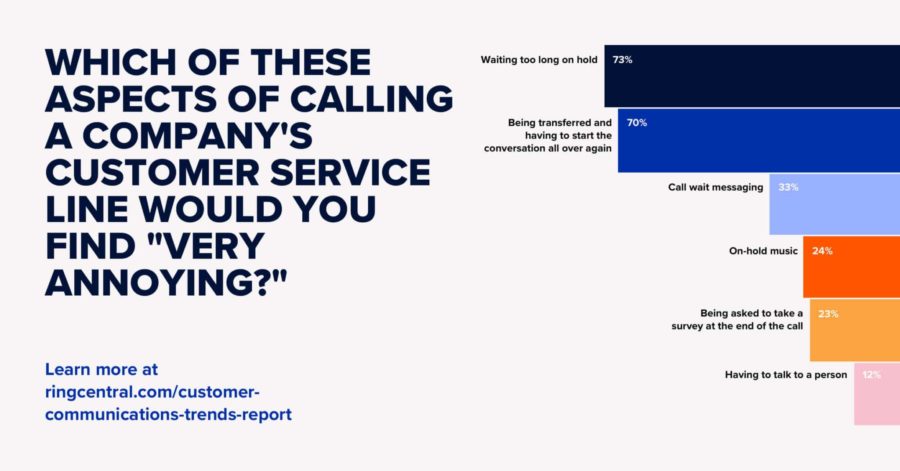For most contact centers, their biggest goal is to provide exceptional customer service. How to do this? The first step is to improve first call resolution (FCR).
Improving FCR can yield countless benefits for your business, including lower costs, improved employee productivity, and a better customer experience.
In this article, we’ll cover what FCR is, examine its challenges and benefits, and share some best practices for improving it in your contact center.
Keep reading to learn:
- What is “first call resolution”?
- What is first call resolution in a call center?
- What is the industry standard for first call resolution?
- What is a “good” FCR?
- Why is first call resolution so important?
- How do I improve my first call resolution?
- Improving FCR: 4 tips for agents
🔑 What’s the key to improving FCR? Grab our customer-centric eBook to find out.
What is “first call resolution”?
First call resolution (FCR), also known as first contact resolution, is an important metric for monitoring customer service. It measures a company’s ability to handle and resolve customer calls, emails, and other support requests across different channels in the first interaction.
What is first call resolution in a call center?
FCR is one of the key call center metrics used to assess customer service standards. It’s a way of understanding how effectively your team is handling customer support requests the first time around, without the customer having to call back.
What is “first contact resolution rate”?
First contact resolution rate is pretty similar to the idea of first call resolution, except as you can probably tell by the name, it refers to the percentage of all customer support requests (not just calls) across channels like live chat and social media that were successfully resolved during the customer’s first interaction with a customer service agent.
First contact resolution rate formula
To track your FCR performance, there’s a simple formula to follow.
To find your FCR rate, divide the total resolved cases in the customer’s first interaction by the total number of cases in a day. Here’s the formula:
A high first contact resolution rate means that your team is effectively resolving support issues the first time they arise, without the customer having to call back or turn to a different support channel.
What is the industry standard for first call resolution?
It’s hard to provide a definite answer to this question, as FCR rates differ across businesses and support teams. It also depends on the number of customers, the budget businesses allocate towards customer service training, and how complex your product is.
However, research has shown that the industry standard first call resolution rate is approximately 74%. However, this varies of course according to the nature of the request, request platform, industry, etc.
Generally, FCR rates close to 90% are considered high, while 40% is considered the “low” end.
What is a “good” FCR?
If the industry standard first contact resolution rate is 74%, we could say that everything above that should be considered “good”—right?
Well, not exactly. FCR rates can’t be compared with the rates of other businesses and organizations whose processes, teams, and technology are quite different from each other.
Companies that have an effective self-service strategy in place to help customers find their own solutions, for instance, will receive trickier requests that may take a second call or an escalation to solve. This lowers the FCR rate compared to competitors with no self-service at all who will still deal with simpler support requests.
And that’s not all. FCR rates vary not only across industries, but within certain sectors as well. It’s also important to note that different companies might measure FCR in different ways that are more effective their specific business—there’s just no one right answer.
While we can say that a high FCR is generally a good thing, it’s not always as simple as looking at the big picture and comparing rates against competitors.
Why is first call resolution (FCR) so important?
If your business strives to deliver quality customer service, then FCR should be a crucial focus. FCR is so important because:
- It helps you retain customers: Poor customer service is one of the main reasons that customers change their business loyalties. Solving pain points at the first customer interaction can be the difference between whether they stay or go. If a customer is dissatisfied with their service experience, they might turn to your competitors.
- It can turn dissatisfied customers into satisfied ones: 32% of customers will leave a brand after a single bad experience. And if you’ve been on social media or read reviews on Google, then you know that unhappy customers will sometimes vent their frustrations online in public. If you have a good FCR, it can turn potential brand detractors into brand promoters (used in measuring the Net Promoter Score, or NPS)—provided, of course, that you can effectively solve their requests.
- It maximizes agent productivity: Solving a customer’s issue during the first interaction means that your support team will deal with fewer repeat requests. This results in shorter wait times for customers and more time for support staff to spend on more complex requests.
Challenges of improving first call resolution
There are many challenges businesses face when it comes to FCR. And a lot of these challenges to first call issue resolutions have to do with technology—for example:
- Complex IVR menus
- Long hold times
- Insufficient or inaccessible information
- High agent turnover
- Lack of agent authority (in extreme cases, would your team have the authority to take more drastic measures to help a customer, for example, by offering a discount?)
The good news is, customer service technology has come a long way in recent years. There are different ways to address challenges by implementing improved call center software, speech analytics, and customer feedback. (A good first step is to streamline the way your contact center handles FCR data.)
How do I improve my first call resolution?
You’ll need to outline clear goals, understand how to track FCR effectively, and put an improvement plan in place. Once your plan is put into action, remember to measure performance, track benchmark metrics, and stay on top of tech trends. Below are some best practices for improving FCR in your contact center.
1. Find the root cause behind delayed first contact resolution
Getting to the root causes behind a low FCR rate will help you to identify common issues, inefficiencies, and knowledge gaps. Armed with this information, you can take the necessary actions to improve FCR. To identify issues, ask yourself these questions:
- Why are support requests taking place across different channels? (e.g., phone, social media, email, etc.)
- Why wasn’t the caller satisfied during the first call?
- Why are calls being transferred?
- Who are calls being transferred to?
- Why was the call routed to the wrong department?
How can you find the answers to these questions?
- Examine the data.
- Refer to call logs and recordings.
- Analyze customer feedback.
- Ask your agents.
Ensure that you’re consistently analyzing the support process and FCR rate. This way you can continue to improve and streamline support processes as your business grows.
Of course, it helps if you have the right system in place. Is your team equipped with cutting edge features such as business phone service, CCaaS, virtual call center, and video call?
2. Create an informative knowledge base
A knowledge base is a key component of your customer support strategy. Provide your customers with access to a self-service help center that they can use to find answers to common questions.
Create a knowledge base that features articles, video explanations, and tutorials. By empowering customers to find their own solutions to their problems, you can reduce the costs involved in extra workloads for call center agents, and maximize their productivity.
When it comes to setting up your knowledge base, remember to:
- Ensure that you have a robust and intuitive help-desk software
- Organize its contents so that customers can quickly and easily find solutions
- Include content that is well-written and accessible
In many cases solving a customer’s pain point can be as simple as sharing an informative article from your knowledge base. This improves FCR by ensuring customers that reach out for help regarding frequently asked questions via phone, email, or social media can resolve their issues and won’t have to contact you again.
3. Analyze customer behavior and anticipate their needs
The more you know about your customers, the better. Understanding why your customers are calling for support is a key factor in ensuring your support team is prepared to meet their needs.
Anticipate the issues your customers might encounter, before they occur. This will improve customer satisfaction and FCR. To do this, you should analyze customer feedback and note down the frustrations they encounter when using your product or service.
This data will provide insight into common concerns the customer might have after the call. You can anticipate their needs during the first call and save them from having to reach out again in the future.
4. Require minimal customer effort
Customers expect fast and easy service experiences. Ensuring customers don’t have to jump through hoops to acquire sufficient support is crucial to customer service success.
93% of customers are more likely to make a repeat purchase from a company that offers excellent customer service. Solving issues efficiently and effectively the first time around results in better FCR rates and improved customer retention.
Consider implementing a call center software that provides intelligent routing features. For example, RingCentral’s Contact Center solution gives you:
- Skills-based routing to connect your customers to the best agent. This ensures that customers are paired with the agent most well-equipped to handle their requests quickly and effectively, without having to wait in a general queue. If there’s one thing customers hate, it’s waiting:
- Omnichannel routing so that customers can reach out to you on any channel at any time. If a customer reaches out on Twitter, then calls you, would you be able to see the full picture of these interactions? (You should be able to!)
- AI digital routing that uses machine learning to effectively understand message intent and route messages accordingly. For instance, RingCentral’s AI digital routing can recognize 72 different languages, as well as text semantics, email metadata, and more for more effective routing.
- Voicemail routing that gives callers the option to leave a message or receive a call back later to ensure all calls are properly prioritized.
- Last but not least, data-driven routing uses open APIs to use backend data to make better connections, build better relationships, and improve first call resolution.
Here’s a quick look at how it works:
Businesses today have to be able to provide omnichannel customer service across different digital channels like phone, email, social media, web chat, and more. Again, RingCentral lets you consolidate conversations with customers across all these channels in one convenient dashboard:

It’s important to make sure that your support channels are optimized for mobile so that customers can get in touch whenever and wherever is most convenient for them.
🕹️ Get a hands-on look at how RingCentral can help you achieve a high FCR—book a product tour:
💰 You can also use this calculator to see roughly how much your business could save by using RingCentral to support your team’s communication with each other—and clients.
💡 Pro-tip:
Make sure that your contact information can be easily found. Do this by including clear links on your website, support center, and products themselves.
5. Provide effective agent training
If you want to improve your FCR rate, a good place to start is by providing effective coaching for your customer support agents. Support agents should be well-informed about products or services, and trained in how to handle difficult queries and upset customers. Moreover, they should never stop learning. (Nor should you: implementing a workforce management or call center management tool can be hugely beneficial.)
Hold frequent coaching sessions to ensure your support team staff are always equipped with the knowledge they need to effectively solve customers’ problems during the first call. This prevents them from sharing inaccurate information, or having to escalate the call.
Sometimes the right agent won’t be available to answer a call. To plan for occasions like this it’s important to cross-train employees across various areas. If every agent is coached on troubleshooting, you can prevent cases like this from negatively impacting your FCR rate.
6. Follow up with post-call surveys about the customer’s experience
A great way to measure FCR and customer satisfaction (CSAT) is to ask customers to answer a phone survey after the call, or send a follow-up email.
Consider asking if they’re satisfied with their support experience, whether their problem was effectively resolved, and if they’d recommend you based on their customer service experience.
Conducting this outreach is a great way to get valuable insight into your FCR and will help you to address dissatisfied customers directly and immediately.
7. Empower your customer support team
There are a few ways that you can empower your support team to improve FCR.
Review your customer service procedures often to ensure certain internal policies aren’t hindering your agent’s ability to effectively resolve problems during the first call. If your team isn’t authorized to carry out certain activities with approval from a senior manager, it might result in drawn-out support calls—and lower FCR rates.
Consider reviewing your more complex processes and empowering your support staff with more authority to resolve support tickets without having to transfer calls or keep customers waiting. It can be worth allowing your agents to:
- Issue returns and refunds
- Adjust billing cycles
- Remove shipment charges
- Apply discounts
It’s important to empower your support team with the best tools to efficiently solve customers’ pain points and avoid repeat calls.
Collaboration tools and instant messaging can promote FCR by enabling service reps to tap into other resources while remaining connected to the customer. Additionally, customer context data gleaned from CRM can provide agents with backstories and guidance for scripts or business rules, as well as informing advanced call routing.
Another essential tool for customer service teams is a unified agent desktop (UAD). This can streamline training processes and make it easier for agents to navigate back-end systems to handle customer requests more efficiently. This reduces the transfer and escalation of complex tickets, allowing them to resolve issues faster.
8. Motivate your customer service team
If you want to achieve better FCR rates, make sure your agents are happy. Motivating agents and boosting company morale will result in more productive agents who are eager to assist customers.
73% of customers fall in love with a brand and stay loyal as a result of friendly customer service reps. With this in mind, it’s clear that happy agents means happy customers. When employees are motivated to come to work, they’re more likely to take the time to properly answer questions and deal with customer frustrations effectively.
Quantity of calls handled in a period is one of the most common customer service KPIs, however, it shouldn’t directly affect improving FCR. Agents should be encouraged to focus on the quality of a call, rather than the number of calls they can get through.
Ensure that your employees are happy at work and empowered with all the tools they need to provide exceptional customer service.
Improving FCR: 4 tips for agents
Agents are your business’s most important assets when it comes to improving FCR. Below are some tips for agents to handle calls more efficiently:
- Understand the customer’s needs: Listen carefully to the customer’s issues and understand what they need from you. To better understand why they’re calling, you should ask clarifying questions and repeat information back to the customer.
- Set realistic expectations: Once you know what’s required of you to solve the customer’s needs, let them know when to expect their issue to be resolved. This lets the customer know you’re working on their problem and gives them a realistic expectation of how long it’ll take.
- Give clear instructions: Provide customers with clear and detailed instructions regarding any next steps they’ll need to take. If they’re struggling, you can stay on the line with them or walk them through specific processes to ensure they resolve the problem and don’t have to call back.
- Stay positive: Sometimes dealing with dissatisfied customers can be disheartening for agents. It’s important to remain calm and collected in the face of customer adversity. Try your best to solve the customer’s issue or provide them with the next steps to take if it’s beyond your abilities.
Benefits of improved FCR
Improving contact center first call resolution leads to improved CSAT and higher customer retention rates. The fewer effort customers have to make to find solutions to their problems, the more likely they are to stay loyal to your business. What’s more, the relationship between FCR and CSAT is directly linked. Providing a great customer experience leads to happy, loyal customers—and who doesn’t want that?
Improved FCR is also connected to improved agent performance. Empowering agents to solve support requests during the first contact results in increased efficiency and profitability, which means fewer costs for your business. It also means agents spend less time dealing with repeat calls and spend more time handling more strategic sales activities and complex issues.
Taking a systematic approach to improving first call resolution involves a certain amount of effort on the part of your business and your agents. However, by committing time, resources, and energy to improve FCR and customer experience, your business can enjoy long-lasting customer relationships.
Originally published Dec 03, 2020, updated Sep 12, 2024







